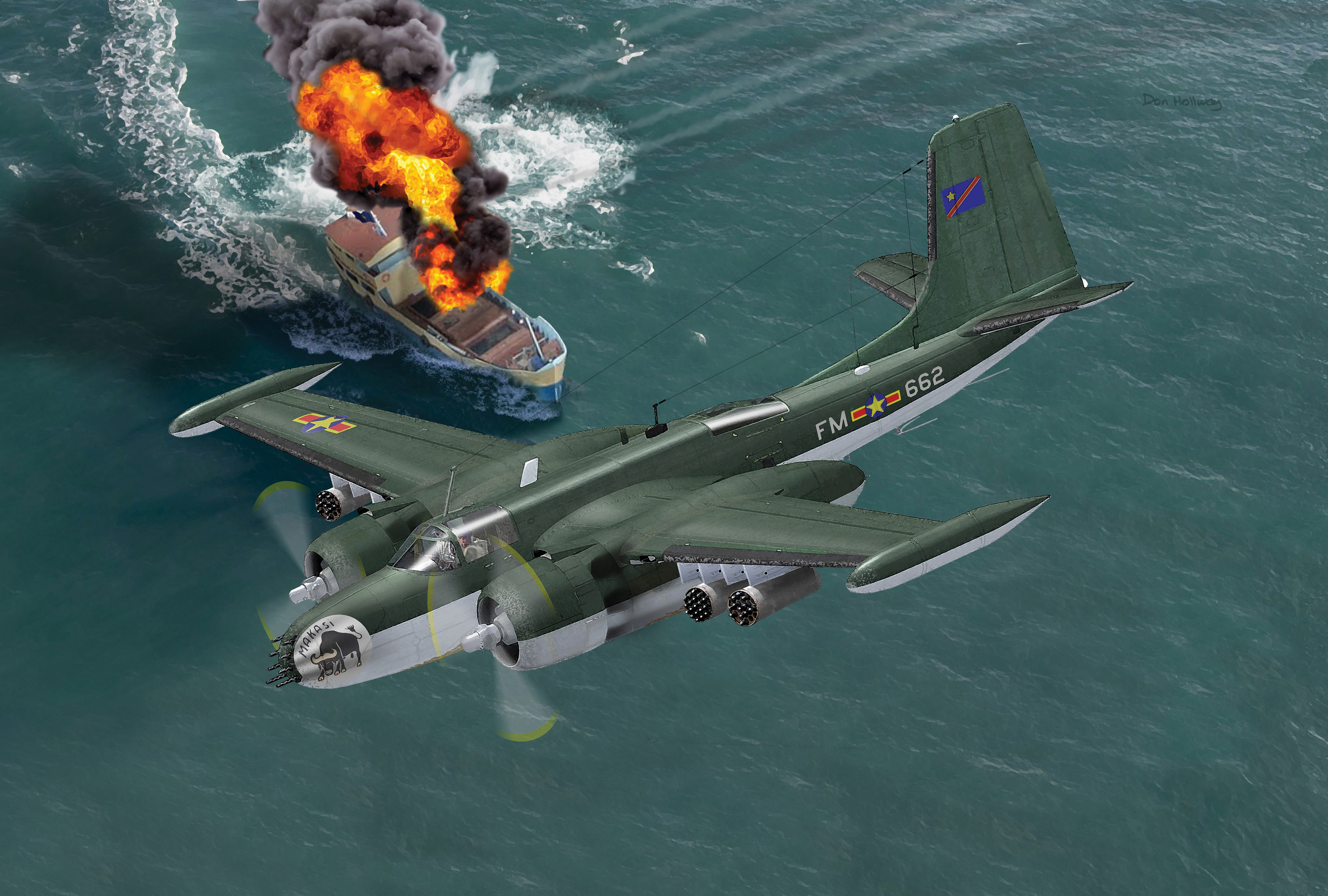Engines warming on the ramp, bombed up, guns and rockets loaded, the Cuban Liberation Air Force was raring to fly top cover over the Bay of Pigs on April 16, 1961, when the United States lost its nerve. No less than a U.S. major general took a jeep out to the flight line at Puerto Cabezas on the Nicaraguan coast to give them the throat-slash, cut-engines wave, then threw his hat to the ground in disgust. “This is straight from Washington,” he fumed. “We can’t make another flight.”
At dawn the previous day Cuban exile Gustavo “Gus” Ponzoa had flown the first attacks on the air base at Santiago de Cuba. In a vintage Douglas B-26B Invader bomber disguised with Cuban air force insignia, he’d blown up a DC-3 he once flew for Cubana Airlines and returned to base feeling “sky high,” positive he and his fellow exiles were going to free their island from Fidel Castro’s Communist regime.
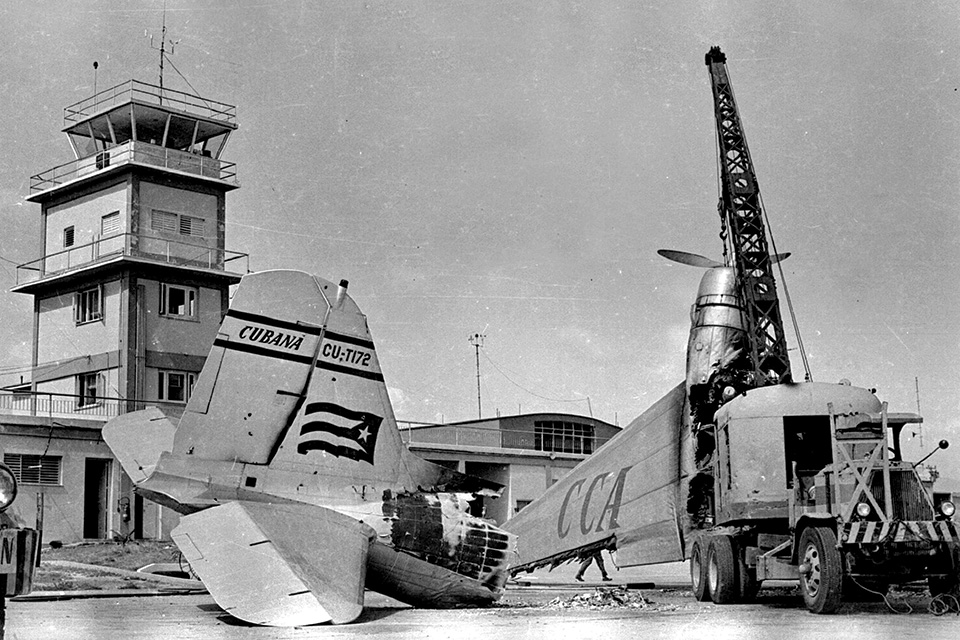
“You couldn’t get a better bunch of guys,” Ponzoa said. “We were strong as hell.” When the White House grounded them, leaving their countrymen stranded on the beach, “It was like a cold bucket of water poured over my head….How can they do this?” The Cuban pilots, their U.S. military advisers, the CIA officers running the show—all knew their counterrevolution was doomed. Castro himself said as much, when asked why the invasion failed: “They had no air support.”
The Bay of Pigs left both the Communist dictator and the Company, as CIA insiders called the agency, overstocked with Latino revolutionaries looking for trouble. Through a Miami front company the agency rehired its exiled vets to form what the New York Times would later call an “instant air force” that could be sent to any hot spot where Washington needed plausible deniability.
BUILDING A COLD WAR AIR FORCE
That turned out to be Africa, where Castro was already sending military advisers and the newly independent former Belgian colony of the Congo was shaping up into a Cold War battleground in 1964. Rebel Simba tribesmen armed with spears and machetes relied on witch doctors and savagery—including cannibalism—to terrify their enemies, but viewed aircraft with near-superstitious fear. Reluctant to become mired in Africa, the U.S. sent its Cuban proxies to help the government put down the rebellion. Exile Félix Toledo was told: “‘When this mission is completed, you will have our unconditional help in the fight against the Castro regime.’ We believed this to be an ideological deal and hence we accepted.”
At first it was sufficient, in their unarmed ex-Italian T-6 Harvard trainers with Congolese colors, to buzz the Simbas at treetop level and frighten them off. But when the rebels captured arms from feckless government forces, the Cuban pilots began taking ground fire. They answered with hand grenades dropped in drinking glasses to release the safety levers on impact, until the CIA sent machine gun pods, rocket launchers and more-powerful T-28 Trojan trainers fitted with .50-caliber machine guns, 500-pound bombs and rockets. “Once the planes were armed,” said CIA Congo Station Chief Lawrence Devlin, “they became an invaluable aid to the government. Without them the government would have fallen.”
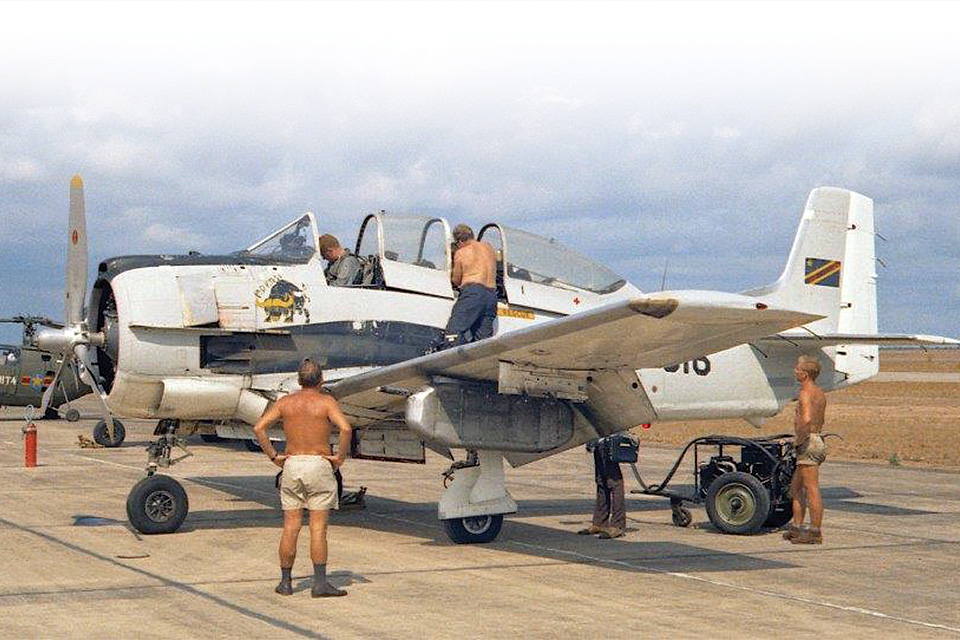
It nearly came to that. By early August 1964 the Simbas had conquered half the country, including the eastern provincial capital of Stanleyville, instigating a hostage crisis. Neither the T-6 nor the T-28 had the legs to cover the Congo’s vast expanse, almost twice the size of France, Germany and Spain combined. The Company delivered up the old familiar B-26, but the exiles refused to fly them. The Invaders had served from World War II through Korea, and were lately starting to shed their old wings in hard maneuvers. “The normal B-26s were not suitable for the Congo war,” said mechanic Segisberto Fernández. “…In fact, our pilots preferred the T-28.”
Way ahead of them, the U.S. Air Force had revamped 40 Invaders to a new B-26K “Counter Invader” standard, with fresh wings, upgraded engines, wingtip fuel tanks and more. Over the Congo their bomb bays packed internal fuel for even more range and loiter time, since bombs and napalm were political overkill and eight nose-mounted .50-caliber machine guns and four 19-rocket pods were more than sufficient against the tribesmen. For the Simbas it was a whole new war. A Washington analysis declared, “The relatively heavily armed B-26Ks represent such an escalation of anything ever experienced in this part of Africa that they have caused a profound psychological shock.”
But air power can only do so much. To reclaim the Congo, mercenary Michael “Mad Mike” Hoare enlisted 300 soldiers of fortune. His main column of 200 trucks and jeeps included Swedish armored personnel carriers and a German-made Ferret armored car on point, flying red flags fore and aft. For the Cubans above, everything ahead of it was a target.
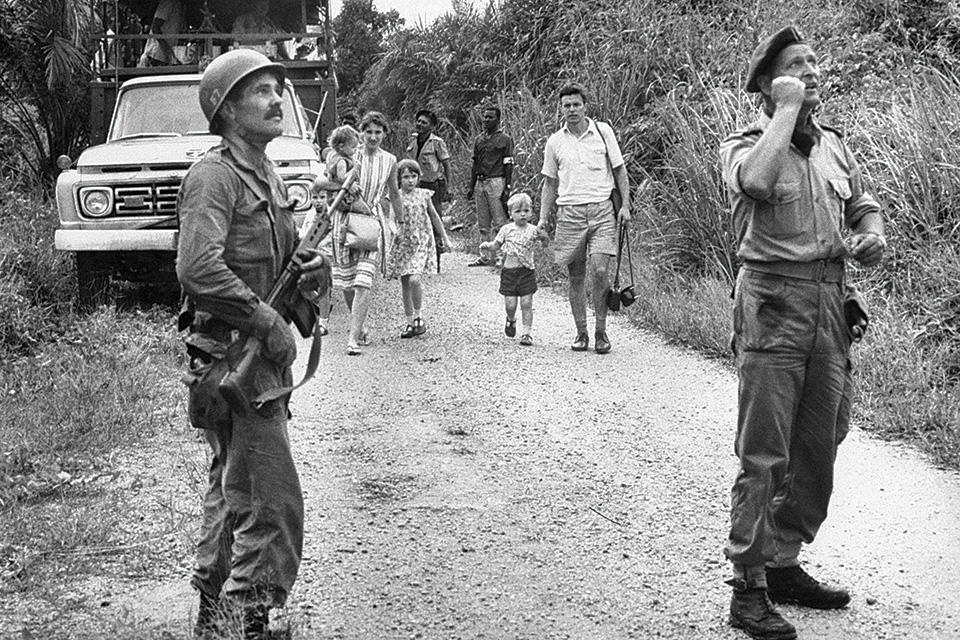
“That was a thick jungle in the Congo, as you can imagine,” recalled Ponzoa, nicknamed El Mirlo, the Blackbird. “We had to fly low—very low, usually following the roads. That was the only way to navigate over that jungle area. I’d spot the enemy and I’d radio down to Hoare’s men: ‘Throw a smoke grenade, let us know where you are.’…Hoare would radio up, ‘We’re down here! You guys are gonna hit us! You’re too close!’…It took a couple of missions before Hoare felt comfortable with the Cuban CIA air support. He’d never had any that was quite that close before.”
On November 1 the mercenary advance reached a rebel headquarters upstream from Stanleyville at Kindu. Ponzoa reported: “As we approached what appeared to be the town square we saw that the rebels had taken all the male hostages to the square, stripped them to their underwear and prepared to execute them. There was no time to ask [ground forces] for a decision; we strafed the would-be executioners and radioed for the invading forces to move.”
In his memoirs, hard-bitten mercenary Hoare remembered his air cover with childlike enthusiasm: “The warplanes came screaming down from 5,000 feet, each blasting off its eight Browning .50 machine guns in a terrifying cruuuump! Now two Bravos came out of the sun and loosed off their rockets in a silent swoosh to explode on the target with a sonorous didoom!”
“He saw that we knew how to fly—and how to shoot,” said Ponzoa. “From then on, he couldn’t do without us. He was always slapping us on the back when we met, all smiles.”
CUBAN VS. CUBAN
Evidence began to mount, however, that they were up against more than blood-mad tribesmen. Hoare’s mercs captured 60mm mortars bearing Chinese inscriptions. Enemy ground forces cut in on copilot Reginaldo Blanco’s radio to trade curses with him in Spanish. “I didn’t see Cubans from the Castro regime as my countrymen,” he said. “I saw them as the enemy.”
“We knew the Cubans were trying to get a stronghold in Africa,” said Bay of Pigs veteran Frederico “Freddy” Flaquer, “and we knew not only were we going to fight the Communists but it was going to be Cuban against Cuban.”
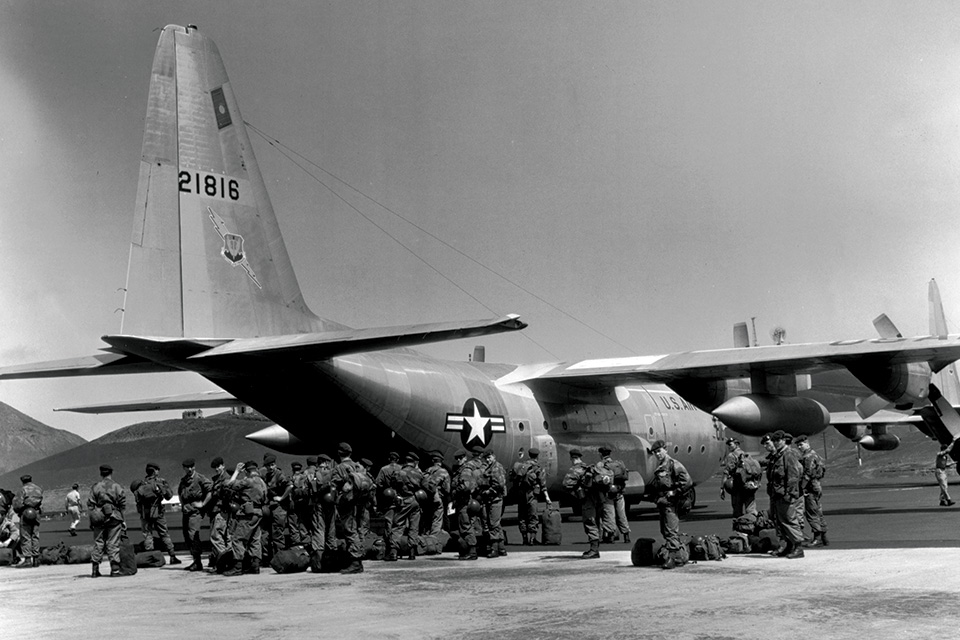
But first came rescuing Western hostages in Stanleyville. At 5:45 a.m. local time on November 24, 1964, two Counter Invaders led the way, destroying rebel anti-aircraft guns at the airport. Belgian paratroops arrived in USAF C-130 transports staged out of the British base on Ascension Island. The CIA’s Cuban ground fighters saw to the rescue of captive Americans. Even with Simbas still threatening one end of the runway, the air contingent landed that afternoon to take over. Hoare’s mercenaries liberated a Makasi (“strong” in the Lingala language) Beer brewery, and with typical combat pilot bravado the Cubans adopted the brand’s snorting-buffalo logo as nose art.
The liberation of Stanleyville infuriated the rebels’ Soviet and Chinese supporters. Castro’s right-hand man, Ernesto “Che” Guevara, viewed Western victory in the Congo as a setback in their global revolution. He soon departed for Africa to lead the campaign himself, but like the exiles would find it quite different from fighting in Cuba. “At least two of our guys were shot down in the Congo,” Blanco recalled, “and both of them were eaten.”
By mid-1965, as proven by captured documents, Guevara commanded 200 Cuban fighters in-country, with weapons entering the Congo from Tanzania across Lake Tanganyika. In response the CIA set up a “Makasi navy,” including a pair of radar-equipped Swift boats imported in sections aboard C-130s. With Cuban exiles overhead by day and gunboats patrolling the water by night, supplying Guevara became exorbitantly expensive. Swift crewman Generoso Bringas recalled, “We confiscated a shipment of Chinese weapons to Congo which was valued at $2 million in 1965 [$16.5 million today].”
“We had overwhelming superiority on the water and in the air,” said Hoare, who assembled a veritable invasion fleet on the lake. “…The convoy made an impressive sight as six T-28s and two B-26s flew overhead….Two hundred voices raised a cheer, as they dipped their wings in salute.”
Bad weather, however, grounded the air force when the troops hit the beach. Rebel opposition, fighting in disciplined European style from fixed positions with heavy weaponry, pinned the mercenaries down until the skies cleared. Then, Hoare recounted, “Six T-28s swooped down low over our position and began to strafe the enemy. As though to make up for their absence the previous day, the Cubans put on a show of aerobatics to beat any flying display, their white wings flashing in the sunlight.” After several days of air attacks Guevara’s men abandoned the fight. The Simbas went back to relying on magic, made an old-fashioned charge and were slaughtered.
“This little air force,” Guevara wrote Castro in October, “is sowing terror among the Congolese comrades.” His Soviet and Chinese suppliers never gave him what he needed most: anti-aircraft guns. The rebels’ AA defenses came to just 10 12.7mm machine guns—little more than was carried in the nose of one B-26K. Harried from the air and on the ground, in November 1965 Guevara made a forced retreat back to Tanzania, and by the end of the year the Simba rebellion was strangled.
DISAPPOINTMENT AND PRIDE
Hoare went home to South Africa, but some of the government’s French and Belgian mercenaries had been lording it over eastern Congo too long to give it up. In July 1967 they staged their own revolt. For a few weeks it was mercenary versus mercenary, but the rebel commandos made the same mistake the Simbas and Guevara had. Strafing and rocketing, the Makasi air force drove them out of the country.
The exiles hadn’t fought for money. Bringas took a pay cut to join and received his bonus pay in worthless Congolese francs. “The only bonus we got at the end of our tour of duty was a large disappointment,” he said.
On their return from Africa the Cubans found a changed world. President John F. Kennedy and Soviet leader Nikita Khrushchev had made a mutual hands-off agreement about Cuba, and though both were gone, their successors stuck to it. “When we returned from Congo, our leaders were told that conditions had changed, and that they were no longer in a position to help us,” Félix Toledo said. “The rug was pulled out from under us.”
Like many Cuban Americans, the Makasis longed all their lives for a free Cuba. No one can say they didn’t do their part. “For me it was a privilege to fly with these people, the ones who died—the Americans, the Cubans,” said Gus Ponzoa at the 2004 groundbreaking for the Bay of Pigs memorial at Miami Executive Airport. It includes a restoration of the B-26 he flew in the aborted liberation attempt. For him and all the other Cubans who flew and fought in the Congo, the Makasi air force at least helped to even that score.
Frequent contributor Don Hollway recommends for further reading Cold War in the Congo, by Frank R. Villafaña. For more about the Simba Rebellion, see “Mad Mike and His Wild Geese” at historynet.com.
This feature originally appeared in the January 2021 issue of Aviation History. To subscribe, click here!
Are you ready to add a clandestine “Makasi” AT-28 Trojan to your collection? Check out our exclusive online modeling column!

